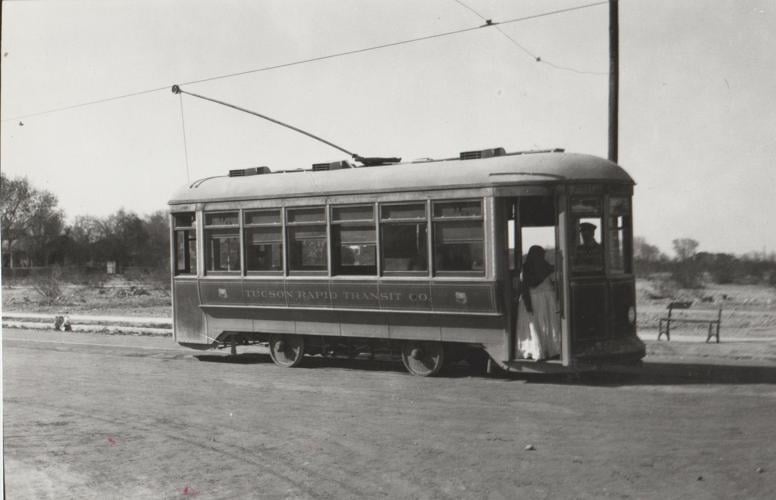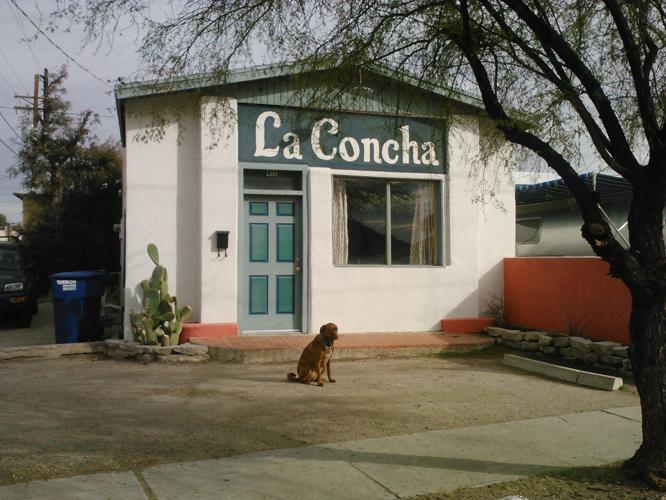The history of public transportation in Tucson is said to have begun in 1879 with Bill Morgan’s herdic line — small, two-wheeled carriages with entrances in the rear.
Three years later, due to growing demand, the Tucson Land and Herdic Coach Co. began operations. It remained in business until 1888.
In 1896, Lulu May Nelson recorded her subdivision, the University Extension Addition, north and east of the University of Arizona. She also likely named Wilson Street after City Councilman Thomas Wilson. This was the first recorded name of what is now Speedway Boulevard.
Nelson also founded a horse-car line, fittingly named the Nelson Streetcar line, in connection with her subdivision, but it lasted less than a year.
The Tucson Street Railway was organized in 1897, and the following year regular mule-car service began. By 1903, four miles of tracks covered parts of present-day downtown and the university. A couple of years later, financial problems forced the streetcar company into receivership and it was reorganized as Tucson Rapid Transit Co. (TRT).
By 1906, TRT had replaced mules with electricity to power its vehicles. The same year saw the first fatal accident of the new electric-car line, when Alther Feldman — the namesake of Feldman Street, the second recorded name of what is now Speedway Boulevard — jumped from a moving car and hit his head on a rock near the track.
In 1910 Tucson Rapid Transit published its intent to add more tracks for its electric cars, but lack of funding prevented that from happening.
The early 1920s witnessed the incorporation of the White Star Bus Line, which TRT opposed in court, claiming it needed the ridership to maintain its lines. The Arizona Corporation Commission viewed the situation differently and granted the application. Soon TRT realized that buses were more flexible and economical than streetcars and purchased White Star in October 1925. This small company became the foundation for TRT bus service.
Also, in the mid-1920s, competition arose in the form of Occidental Bus Lines. The business was founded by Roy Laos Sr., when he noted the absence of services to the south and west sides of town. Occidental operated out of La Concha Service Station and Garage, 415-420 S. Meyer Ave. It was later called Old Pueblo Transit.
Just as electric streetcars replaced mule-driven ones around the turn of the century, a new era for Tucson Rapid Transit began on New Year’s Day 1931, when all electric streetcars were removed from service and TRT became solely a bus service.
In April 1936, Jacob M. Bingham established the Mountain View Bus Line with one bus. His goal was to serve outlying areas not served by TRT routes. The business struggled to pay its bills and in a few years TRT bought it out.
Ridership surged during the U.S. involvement in World War II due to gas and tire rationing as well as to higher demand for public transportation as industrial growth surged.
In late 1951, with construction completed on the new Hughes Missile Plant (now Raytheon), competition began to heat up. Old Pueblo Transit filed an injunction through Pima County Superior Court to stop Tucson Rapid Transit from serving the defense contractor.
On Jan. 4, 1952, the Corporation Commission held a five-hour session and learned that Hughes Aircraft Co., had asked both companies to provide service for its employees. Commissioners also learned that Old Pueblo Transit buses carried about four people to and from the plant each shift. They decided against the company and allowed TRT to operate as a common carrier to the plant.
The 1950s saw a steady decline in ridership for both companies. Tucson historians Cirino G. Scavone and W. Eugene Caywood wrote:“The only reliable source of revenue for (TRT) in the late 1950s was advertising. ... Beginning in 1957 ... large ads were employed and covered great areas of the side of a bus. In 1958, the ultimate use of a bus for advertising began when number 209 was completely painted as a loaf of bread representing a local bakery.”
From mid-1959 to early 1960, air conditioners were added to Tucson Rapid Transit buses.
TRT changed hands in the 1960s and the new owners made few changes to boost profit or enhance the rider experience. The increase in automobiles put a huge dent in the bus line business, and driver’s strikes caused ridership to continue to decline.
The City of Tucson purchased the company in 1969 after executives realized it could no longer stay afloat. City officials renamed it the City of Tucson Transit System. Soon after, a large number of new buses were bought with the assistance of federal grants.
In 1975, a contest was held to rename the bus system, and Benjamin Rios, a 25-year-old University of Arizona architecture student from Cananea, Mexico, submitted the winning entry: “Sun Tran.” His reasoning: “I wanted to reflect the nice weather; I wanted the word sun in there.” His prize was a $150 portable television.
Sun Tran purchased Old Pueblo Transit from Roy Laos Sr. in 1978 and Tucson had one public transit system.
In 1987, the Roy Laos Transit Center opened at 205 W Irvington Rd. Four years later, the Ronstadt Transit Center opened downtown. Part of this center was the former home to the F. Ronstadt Co., a popular hardware store. Digital video recorders were installed on most buses in 2001 and, in 2010, Sun Tran received shipment of its first bus using hybrid technology.
After completion of the Northwest Bus Facility, 3920 N. Sun Tran Blvd, most Sun Tran workers relocated to the new location in February 2012. It sits on land that was once part of the old Gilpin Airport.






